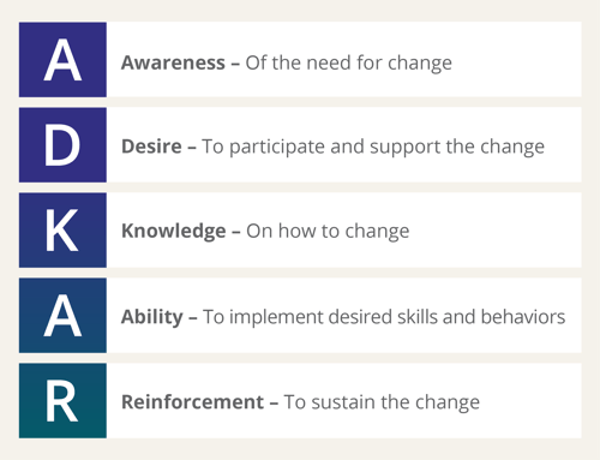20 Change Management Questions Employees Ask and How To Answer Them

10 Mins
Updated: February 12, 2024
Published: January 3, 2024

You need employee buy-in to manage change effectively, but getting them on board can be challenging. They have genuine concerns about changing what they know, how it will impact their day-to-day work, and whether a change is worth adopting.
The good news is that you can prepare for these questions and reassure employees throughout the change management process.
If you're a change practitioner, it's your job to prepare and equip sponsors and people managers for their roles during change—which includes answering questions from other professionals. Read this article to understand employees’ change management questions better and prepare yourself to answer them effectively.
Top Change Management Questions Employees Ask
People always have questions during organizational changes. These are the 20 most frequently asked questions and helpful answers that sponsors and people managers can provide when supporting people through their transitions:
10 Questions An Executive Sponsor Would Answer
Here are 10 change management questions an executive sponsor might encounter about the strategy and reasoning behind the change.
1. Why is change happening now?
Employees may feel like change is happening suddenly. In reality, most changes begin months or even years before internal changes take place.
Most major business changes are a response to changes in the external marketplace. These external marketplace changes can result in the following:
- Loss of market share, causing your company to lose money
- New offers or capabilities by competitors where they're creating new business faster than your company
- Lower prices from competitors resulting in better prices for their customers
- A new business opportunity for growth
External business drivers take time to set in. If they’ve already affected your organization's bottom line, change is needed immediately. In some cases, it is already too late—the internal change should have started much sooner.
How to answer: Explaining the reasoning behind change is vital to effective change management. It helps employees understand why implementing change is necessary now and the long-term benefits of adapting to the change. As a result, they can better understand why the change is necessary, which can increase buy-in.
2. What Is the risk of not changing?
When the idea of change becomes prevalent, employees may naturally wonder about the risks of not adapting.
For employees, the risk of not changing could mean:
- Job security. Without change, the company may become less competitive, leading to downsizing or closures, directly threatening employees' jobs.
- Skill obsolescence. As the industry evolves, failure to change can leave employees' skills outdated, reducing their marketability and career advancement opportunities.
- Decreased morale. Stagnation can lead to a demotivating work environment, as employees see a lack of investment in progress or improvement in their work conditions.
- Limited career growth. Without change, there will be fewer opportunities for employees to take on new roles or responsibilities, hindering their professional development.
- Poor job satisfaction. Continuation of inefficient processes or outdated tools can lead to frustration and dissatisfaction with daily tasks.
For the organization, the risk of not changing could mean:
- Loss of competitive edge. Inability to adapt to market changes can result in falling behind competitors, losing market share and revenue.
- Innovation stagnation. Without change, the company risks missing out on new technologies or methodologies that could drive future success.
- Financial decline. Failing to change can lead to inefficiencies and increased costs, impacting the bottom line and the ability to invest in new opportunities.
- Talent attrition. A lack of change can lead to high-performing employees leaving for more dynamic and progressive competitors.
- Reputation damage. The perception of being outdated or resistant to change can harm the company's brand and its appeal to customers and potential employees.
How to answer: Answer this change management question by explaining the benefits of enacting change compared to the risks of not changing to ensure that all stakeholders understand the urgency and necessity of the change initiative.

3. What’s the rush?
Organizations don’t always share financial information or talk about poor performance with employees. They usually find out what's happening after the fact, meaning they don’t have any concept of the change timeline or the reasons behind why change is needed so fast.
How to answer: Give employees insight into the bigger picture to help them understand the timeline of change. If you force employees to change without explaining the reasons behind it, it can be a lot like pushing a giant cube of gelatin—you might make an impact, but no real overall shift occurs. When the force is removed, everything returns to the way it was before.
4. If I wait long enough, will the change go away?
In most cases, an organization will implement a change even when employees resist it, especially if financial success is at stake. In other words, if the financial success of an organization depends on a change, employees should expect it to happen with or without them. Waiting usually will not change the outcome.
This doesn’t mean that the change is bad for employees. In the end, many changes result in positive outcomes for employees, including better tools, improved work processes, more secure jobs, and new opportunities for career development.
How to answer: Explain that the change is 100% going ahead, and reiterate how it will benefit employees. Sitting back and waiting for it to disappear is time that could be better spent preparing and understanding the change.
5. What are the benefits of supporting the change?
Employees want to know how change will improve their day-to-day lives. Improvements vary depending on the type of change, but here are some of the common benefits:
- Professional growth. Embracing this change opens up opportunities for skill development and career advancement as the organization adopts new technologies and processes.
- Increased job satisfaction. Being part of the change process gives employees a voice in shaping the future, fostering a sense of ownership and satisfaction in the work they do.
- Improved efficiency. Process and technology changes can streamline workflows, which reduces frustration from outdated practices and help employees focus on more rewarding aspects of their job.
- Cultural evolution. Adopting a culture of innovation and resilience makes workplaces more dynamic and responsive to future challenges.
How to answer: Outline the benefits for each position to ensure everyone fully understands the need for change. These vary from person to person, depending on their role in the company.
6. What if I disagree with the change?
Employees shouldn’t be afraid to voice objections or concerns. If they have change management questions to ask, they should get it out in the open so everyone’s on the same page. If their objections are valid, challenges will be brought to light—and you’ll have a chance to resolve issues before moving ahead with a successful change management process.
How to answer: Listen to and address their concerns. Employees who feel listened to are much more likely to be receptive to your response.
7. What if change has failed in the past?
The history of your company may include some previous change projects that failed. If failure to change is what employees are accustomed to, they may have a hard time forgetting the past. For organizations to be successful, everyone must be prepared to accept the past as history, learn from it, and focus on what lies ahead.
How to answer: Address previous attempts and show employees how you’ve learned from these failures and incorporated this knowledge into the new change plan.

8. How will we mitigate customer impact?
It’s not unusual for employees to show concern about how changes impact the customer experience. They care about their job and the company, and want to ensure that change doesn’t come at the expense of the customer experience.
How to answer: Explain how you will support customers through the change so their experience isn’t affected negatively. Share any communication plans, timelines and processes you will put in place to mitigate any potential issues customers may face during the transition.
9. Why do we need change in the first place?
Employees asking this change management question may not understand the reason behind the change. They likely see it as a hindrance, as they’re invested in the old approach or may have even helped create the old approach. Employees may also fear that the new approach will change their status with peers.
How to answer: Show employees why the change is necessary, and explain how the change will improve the business. You can also highlight how you plan to make the change as smooth as possible—like offering training, resources and other support—to increase buy-in.
10. How does this change align with our long-term objectives?
For employees to feel like it’s worthwhile, they may want a better understanding of how the change will support business growth in the long run. If they can see the bigger picture and how it will impact the growth of the business, they’re more likely to support it.
How to answer: Be specific about how the change aligns with and supports your long-term growth and strategic goals.
By answering these key change management questions, leaders can guide successful changes in their organization, align with long-term goals, and boost employee support and adaptability.
10 Questions a People Manager Would Answer
Read these 10 questions managers might face at the start of the change management process.
11. What will the change mean to me?
Change impacts people differently. With small changes, employees may not be impacted at all. With major changes, they may do new work, use new tools, or report to a new manager. With radical changes to the business, some employees may need to work in other departments or even move to other organizations.
How employees react to change also influences how it impacts them.
If they’re resistant to change, their day-to-day life becomes harder. If they’re on board with the change, they’ll likely be more capable of adapting to new processes and systems.
Change impacts the business, which affects employees. Changes can include:
- New ways of doing work
- New systems or tools
- New reporting structures
- New job roles
- New products or services
- New markets or geographic locations
How to answer: Break down the impact of change on an employee’s role and responsibilities. The more clarity you can provide, the better employees are likely to respond to it, which makes the entire change management process easier to implement.
12. What are my choices?
An employee’s choice about how to respond to change varies as the organization moves through the change process. Think about the change in these time periods:
- When the change is first announced—but before it’s implemented
- During the change process—when the new solution is being deployed
- After the change is in place—following implementation
Their choices and the consequences depend on the phase. Some choices will benefit you and enhance your ability to thrive in a changing organization. Other choices may have negative outcomes, making it harder to implement successful change.
How to answer: Explain their choices and the consequences of each decision. For example, they can support the change, query its effectiveness, or not support it at all. You can’t control people's choices, but you can provide the information they need to make intelligent, informed decisions.

13. Will I be forced to do more for the same pay?
When your organization is changing, new processes, systems, or skills are common. Your role in the changed environment may include learning these new processes or acquiring new skills.
If you don’t address these concerns, you risk losing employees to other roles. The most common reason for 37% of employees leaving their job in 2022 was because of low pay.
How to answer: Explain that compensation for the old way of doing things may decrease as the organization values that work less and less. However, compensation for new work may increase as the value of new services and products increases. This is a part of change.
14. Will we still get a bonus if we don’t hit new KPIs?
Employees may query their bonuses during organizational change—specifically, how KPIs will change and whether there will be allowances for hitting these goals. It’s up to you to reassure them of how KPIs will be affected and how this could impact their ability to secure a bonus.
How to answer: Explain how the change will impact KPIs and what will happen if they aren’t met. You might allow some leeway to increase employee morale and motivation. Remember that you need employee buy-in for successful change implementation.
15. Who was involved in creating the new process?
Employees may want reassurance that all top-level management—including C-suite employees and other key stakeholders—are invested in the change. This reinforces the idea that the change is necessary and good for the business.
How to answer: Tell employees that all relevant parties have been consulted and are aligned on the change. Outline the reasons why the change is necessary, focus on the benefits, and let them ask questions to clarify the need for change.

16. What if I don’t have time to make these changes?
Change is daunting, especially if employees already have a busy workload. It’s natural for them to be concerned about how much time and how many resources will be required to enact change successfully.
How to answer: Reassure them that you’ve reviewed their workload and outline what you’ll remove to free up capacity for change. Let them know that you’re on hand to support them throughout the process and that they can always come to you if the workload feels like too much.
17. Will this offer new training opportunities?
Change sometimes requires employees to develop new skills or use new systems. As a result, there can be new opportunities for professional development, which can pique the interest of some employees.
How to answer: Outline exactly what professional development and training is necessary to give them an idea of what to expect and how it might impact their professional goals and development.
18. What will my day-to-day look like?
Employees want clarification on how the change will impact their daily responsibilities. Will they have new tasks to complete? New processes to follow? New systems to use? It’s up to you to answer these questions and provide employees with as much clarity as possible.
How to answer: Outline exactly how the change will impact the day-to-day life of each position in the company, including how it will influence their responsibilities, workload and more.

19. Employee morale is low; is change a good idea?
When facing a period of change, it's not uncommon for managers to confront concerns about employee morale. In these moments, it's crucial for leaders to approach the conversation with empathy, acknowledging the team's feelings while also conveying the necessity of the change. A change, albeit challenging, presents an opportunity for growth and improvement that aligns with the organization's strategic goals.
How to answer: Managers should emphasize the potential for positive outcomes, such as enhanced processes and job satisfaction, and stress the importance of open and honest communication. This approach not only addresses immediate concerns but also sets the stage for a more resilient and adaptable team culture.
20. How can we ensure a smooth transition?
When things change, employees might worry about their ability to do their jobs properly.
When answering this question, be honest. It’s impossible to say there will be no effect on day-to-day work, but you can reassure employees that your job is to minimize the impact and ensure the transition is as smooth as possible.
You can also provide some leeway for workloads during the change transition to relieve some pressure and keep morale in a good place.
How to answer: Outline your change management process, including the steps to mitigate disruption to their daily operations. Explain that there may be some disruption, but your goal is to minimize this as much as possible.
Managers can ease the change process by clearly answering key questions and helping employees understand their roles and options. This approach leads to smoother transitions, boosts morale, and prepares the project team for future changes.
How the ADKAR Model Can Help You Answer Change Management Questions
These common questions are all part of building awareness of the need for change. It’s the first element of the Prosci ADKAR Model, a framework for facilitating change. The model is based on the understanding that organizational change can only happen when individuals change.

Answering Awareness-related change management questions enables employees to understand:
- Why is the change happening?
- What's in it for me? (WIIFM)
As a result, you minimize potential resistance, boost employee engagement, and increase support for change.
The Need to Answer Employee Change Management Questions
Effectively answering these 20 change management questions can help you implement change successfully. If employees aren’t on board with change, it halts the entire change management plan.
The good news is that change managers (and other change practitioners) can use approaches and tools from Prosci to effectively prepare for employee questions. As a result, you’re in a much better position to enact change.
Sign up for our Change Management Certification Program to ensure you implement a smooth and successful organizational change in your business. Or, if you've already earned your Certification, enhance your change management skills further by attending one of our advanced change management programs.


